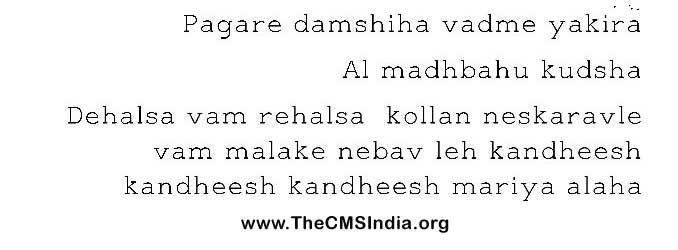\
Encyclopedia of Syriac chants

പഗ്റേ ദമ്ശീഹാ
Anthem of Mysteries / Pagre Damshiha (Pagre d’mšīhā)
Encyclopedia of Syriac Chants - Index
| CMSI Ref Number | (101-0083) EC-0083 |
| Title | Anthem of Mysteries / Pagre Damshiha (Pagre d’mšīhā) പഗ്റേ ദമ്ശീഹാ |
| Category | Liturgical |
| Liturgical Context | Offertory procession during Qurbana
|
The Deacon prepares the bread and wine at the side chapel and carries them in procession to the main altar. During the procession, the choir sings the Anthem of the Mysteries: “The precious Body and Blood of Christ at the holy sacrificial altar.” The anthem varies according to Sundays and feast days. Here is the Anthem for the weekdays. This anthem is significant for several reasons. From a theological perspective, it stands out at this part of the liturgy because the text refers to the bread and wine as the body and blood of Jesus, much before the Eucharistic Prayer (Anaphora) and the Invocation of the Holy Spirit (Epiclesis) after that. The anthem represents an Eastern and pre-“transubstantiation” approach in the history of Eucharistic theology. Poetically, this is an example of a single-strophe hymn that has two incipits. These incipits help the worshippers to sing the same song text with two different focuses. The choir sings the anthem with the first incipit, and the congregation repeats it with the second incipit. The Anthem ends with the song of the Angels in heaven, the Thrice-Holy. This is the third time the Thrice-Holy appears, after the “Our Father” and Trisagion. It will appear three times again, twice in the Anaphora, and once in the communion rite. The last two verses of the anthem reiterate the spiritual bond between the earthly and heavenly choirs. The choir invites the congregation to join with the angels, saying, “with the angels let us shout with joy, “Holy, Holy, Holy, Lord God Almighty.” Thus, the earthly liturgy is simultaneous with the heavenly liturgy, defying the human understanding of time and space.
Also refer - Syriac Malabar Qurbana
|
|
||
 |
|
Transliteration & Translation (English)
| Syriac Text | Translitaration (English) | Glossary |
 |
 |
Pagre = the body; d’ +mšīhā = of the Messiah/Christ; w’ + dme = and his blood; yaqīrā = precious; al = at; madbah = place of sacrifice/altar; qudšā = holy; B’dehalṯā = in awe/fear; wawrēhamṯā = and love; kollan = all of us; neṯqārew = let us offer; le(h) = to him; W’ + am = and with; mālākē = angels; n’yambaw = praise (shout with joy); le (h) = to him; Qandiš = holy; māryā = Lord; ālāhā = God almighty |
Available resources
Aramaic Project Recordings: \
| S.No. | Artist | Youtube Link | Aramaic Project Number | Notes |
| 1 . | Dr. Vellian and Rev. Sister. Dennis | Video | 6E | |
| 2 | Marth Mariam Church, Kuravilangad | Video | 36 | |
| 3. | Fr. George Plathottam. | Video | 70U | |
| 4. | Mar Thoma Sisters | Video | 18D | |
| 5. | Dr. Jacob Vellian | Video | 80P | |
| 6. | Maria Joseph and Bro. Libin | Video | 90 | |
| 7. | Fr. Augustine Kandathikkudyil, | Video | 96 | |
| 8. | St. Thomas the Apostle Syro-Malabar Forane Catholic Church, Dallas, Texas, USA | Video | 100 | |
| 9. | Infant Jesus Church, Koovappadam. Kochi | Video | 122 | |
| 10. | Fr. Cyril Thayyil | Video | 127 | |
| 11. | Annmariya Njarakunnel | Video | 149 | |
| 12. | Choir Team | Video | 155 | |
| 13 | Choir Team of Marth Maryam Forane Church, Kuravilangad | Video | 156 | |
| 14. | Fr. Anthony Kaitharan | Video | AP 206 / AP2-05 | |
| 15. | Bishop Thomas Tharayil | Video | AP 210 | |
| 16. | Fr. George Nellikkat | Video | AP 223 | |
| 17. | Childrem Choir | Video | AP 243 |
Copyright
Copyright: Christian Musicological Society of India. Do not use any part of this article without prior written permission from the Christian Musicological Society of India. For permission please send request to This email address is being protected from spambots. You need JavaScript enabled to view it.


